Best
Piano for Beginners
-
Overall: Boasts A Graded Hammer Standard (GHS) Keyboard With Matte Keytops For A Realistic Piano Feel
-
Best Feature: MIDI enabled and has a USB-B connection, allowing you to plug it into a computer
-
TedScore™: 10/10
Best
Budget Piano
-
Overall: With An Extra Sleek Profile For A Modern Aesthetic And Added Portability
-
Best Feature: Authentic Keyboard Action Encourages Correct Technique
-
TedScore™: 8/10
Best
Piano for Pros
-
Overall: Comes With A Superb Fully-Weighted Keyboard Action
-
Best Feature: Improved Action With New Responsive Hammer Compact Action
-
TedScore™: 9/10
Have you ever been dazzled by the way skilled pianists effortlessly create lovely tunes? The key lies in mastering some essential techniques. Discover this list of piano techniques to unveil the mysteries of playing like a professional.
The right techniques can change your playing, from getting your posture right to putting your fingers in the right spots. Imagine confidently hitting the keys and letting the music flow through your hands.
In this article, we will explore some excellent techniques to improve your playing. Keep reading and start your journey to becoming a great pianist!

What are Some
Common Mistakes When Playing the Piano?
People make many mistakes when playing the piano. One of the most common is not paying attention to fingering and control. For example, playing a chord or part with different fingers can make your playing uneven and sound bad.
Not practicing pieces all the way through is another common mistake. Playing the same part is easy, especially if you can repeatedly.
By practicing the proper piano techniques, like hand position, pedal use, and finger movements, pianists can learn to play more efficiently and effectively.
Playing Piano Techniques Like a Pro
To play piano like a pro, try piano performance techniques. Legato and staccato are opposites and very common.
Legato means smoothly connecting your fingers across the keys. Staccato means sharply touching and releasing the keys.
Both are important and can help you practice scales, arpeggios, and parts of songs. If you usually play legato, try staccato to mix it up. Doing this engages your brain, helps you learn faster, and strengthens your skills

When you practice piano playing techniques, it’s essential to take your time and be deliberate with each note. Before you play a piece on the piano, it’s essential to familiarize yourself with it mentally. This will help you develop a strong sense of music and help you improve your piano skills easily.
Plus, check out these quick tips to help you practice piano-playing techniques regularly to improve your music skills and become a professional pianist!
1. Correct Body Posture
To play the piano correctly, it’s vital to maintain good posture– this includes sitting upright with a straight spine, relaxed shoulders, and avoiding craning the head down to look at the keys. To play the piano effectively, your hand position is also key.
Palms should be facing downward with wrists relaxed and slightly above the keyboard. When setting up the piano bench, ensure it’s at the correct height to suit your build, and sit up straight but relaxed.

Another important mistake to avoid is “the wings”; keep elbows comfortably at your side while playing to avoid “the wings.”

2. Correct Hand & Finger Position
When learning piano, you must first learn proper hand position, which is crucial for piano playing.
The right and left-hand fingers are numbered in a piano sheet music, with the right-hand thumb (finger 1) on middle C and the pinky (finger 5) on the G above. The left hand is the same, just in the opposite direction.
Hand position is important for piano playing and should be taught with palms down and relaxed wrists and fingers slightly extended.
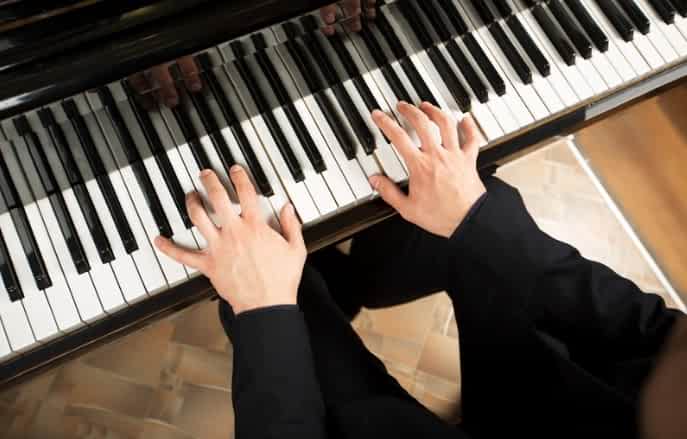
It’s also important to play with the force of the entire hand and not just individual fingers, as this will enable you to play powerful and dynamic passages. Playing with consistent accuracy requires practice and patience from both teachers and students.

3. Learning Minor & Major Scales
Learning major and minor scales is an important step in your piano journey.
Almost every piece of music has hidden scales – and if you know how to play them, you’ll find playing your pieces easier.
And for some reason, we always throw more weight to major scales. I never understood this, as minor scales are just as important!

4. Playing with Octaves
Octaves are an interval of eight notes on the piano keyboard. To play octaves, you must press two keys simultaneously. So octave scales are a technique that involves focusing on hand and body position while keeping the hand, wrist, and forearm relaxed.
Effective practice of octaves involves is important to help develop a relaxed wrist capable of producing powerful sounds.
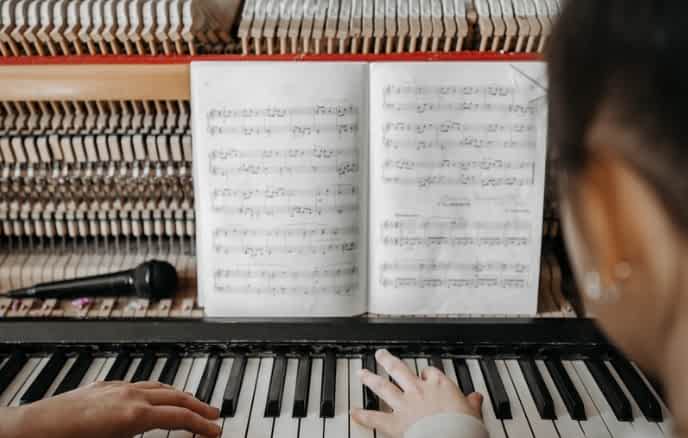
Playing octaves can be a part of many pieces, such as piano rag and classical piano songs. And before I forget, if you can’t reach an octave yet – don’t worry. One day you will!
5. Using Pedals
Pianos have several different types of pedals used to create different sounds. Different pianos use different pedal configurations.
The most commonly used piano pedal is the sustain/damper pedal, which is used to sustain or hold a note after it’s been played. This is always the right pedal.
The left pedal (officially called the Una Corda – meaning one chord/string) is used to play quiet passages even quite.
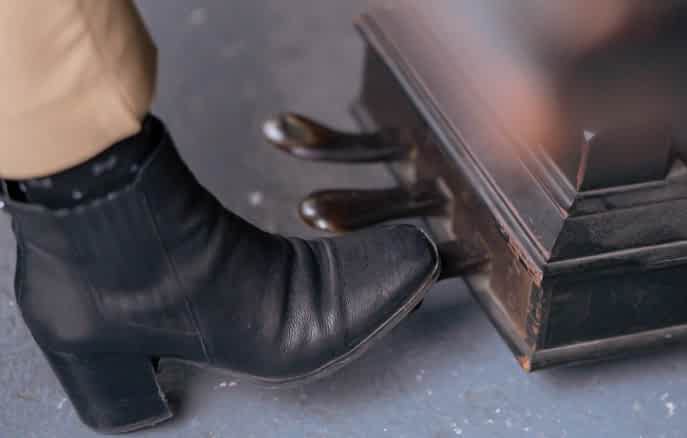
Lastly, if your piano has a middle pedal, and it’s an upright piano, then it’s most likely a ‘Practice Pedal’. This lowers a piece of cloth over the strings, so it makes each note sound more mutes; ideal for practicing when you need to the sound to be quieter without having to have the sensation of playing quietly!
If you’re middle pedal is on a grand piano, or a digital piano, it’s more than likely going to be a sostenuto pedal – meaning it will sustain/hold the specific notes that are press whilst the pedal is activated – but any other notes remain unaffected by the pedal.
Practice Tips for a Beginner Pianist to Remember
If you’re interested in learning piano, it’s important to get professional tips and piano advice from the experts. This can help you focus on meaningful improvement and develop the proper piano technique necessary to become a pianist.
Make sure to follow these practice tips to take your piano playing to the next level!
It's Good to Have a Practice Schedule
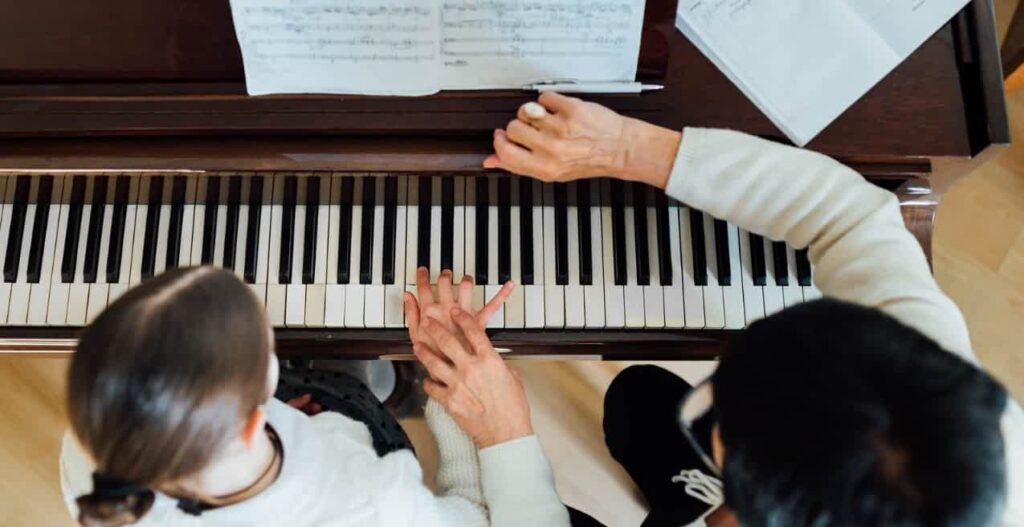
Having a consistent practice schedule is vital if you want to maintain your skills and progress as a pianist. By having a set practice routine, you can prepare for playing in public with confidence. It’s also important to commit to a certain amount of practice time each week so that pianists can improve their playing abilities over time.
Practising away from the piano can help improve muscle memory when playing the piano. This can help with playing the piano without relying on memory too much.
It’s also helpful to record your practising from time to time and listen back; you’ll learn from it and improve your playing technique.
Additionally, it’s good to have some quiet time after practice to reflect on your practice and work on any technical challenges you’ve encountered.
Having a Clear Goal in Mind During Practice
It’s essential to have a clear goal in mind during practice if you want to become a successful pianist. It’s important to plan what pieces, exercises, and techniques you want to work on each day.
By having a clear goal in mind, you can stay motivated and focused during your practice time. It’s also important to be patient with yourself and not be too hard on yourself if you make mistakes.
Instead, learn from your mistakes and strive for improvement each time you practice.
Ask for Feedback from Professionals
Start by asking for feedback from piano experts. Whether it be from a teacher, online piano community, or YouTube video, ask for feedback on your technique.
Remember to be self-critical and use tools such as a mirror, recording yourself while playing, or having an observer listen in while you play.
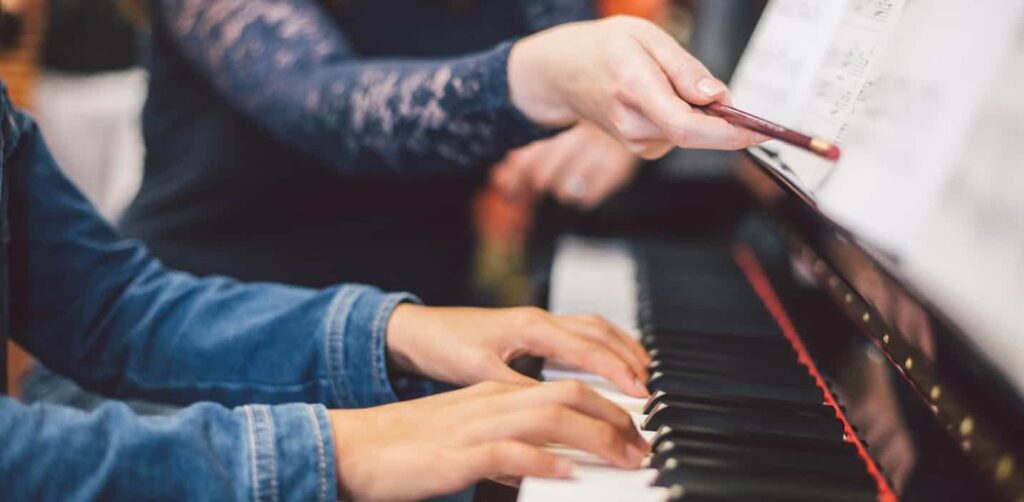
Use these techniques to evaluate your technique and improve your play over time. Remember to take notes and analyze your performance, so that you can learn how to get better at playing the piano.
Recommended Pianos for Beginners
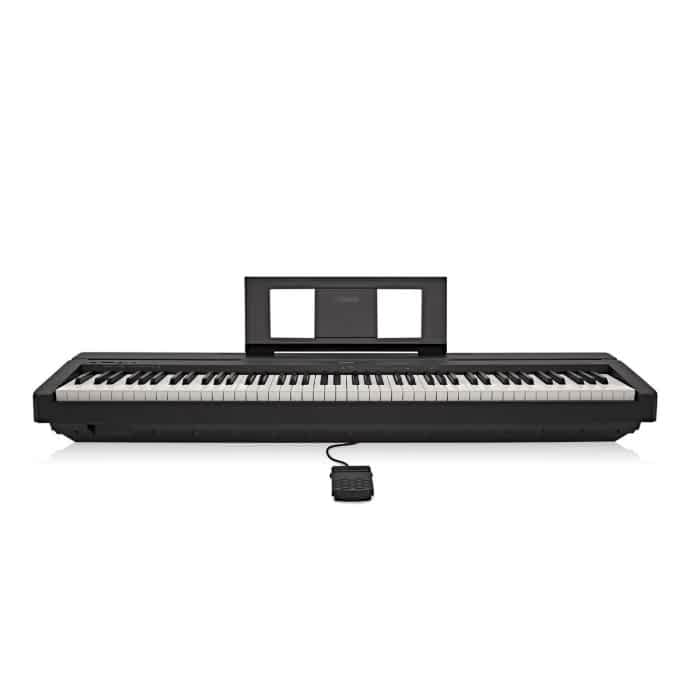
PERFECT FOR: New musicians
FEATURES: A teacher's favourite for learning with graded hammer action keys
OTHER INFO: With a graded standard hammer keyboard and sustain pedal for an authentic playing feel
Yamaha P45 Digital Piano
When you check the price above, you’ll see there are loads of great places to buy this item. Our personal favorite is Gear4music.
It is the largest music retailer in the UK and fast becoming the most respected online music shop in the US too. Their customer service is excellent, they have competitive prices, really fast shipping, and usually have the longest guarantee.
Most professional musicians use Gear4music, so there is no reason why you shouldn’t too!
- Legendary Yamaha quality
- Includes three months of Flowkey Premium
- You'll need to purchase a stand and bench separately, which can add to the overall cost
The professional musician who wrote this article combined many things,
from the product build, manufacturer’s reputation through to feedback
from other users, to create our famous TedScore™.
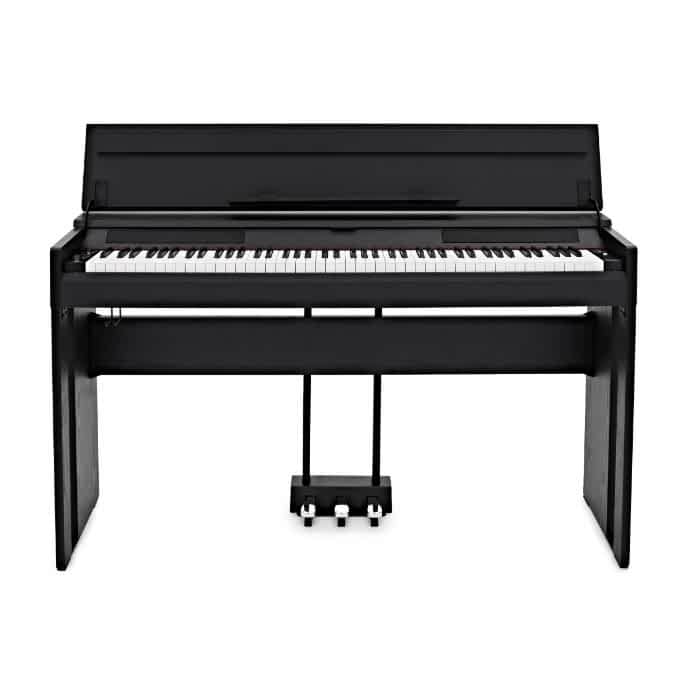
PERFECT FOR: Learning at home
FEATURES: 88-key digital piano ideal for living spaces
OTHER INFO: Synthetic ebony and ivory keys provide that premium grand feel
DP-12 Compact Digital Piano by Gear4music
When you check the price above, you’ll see there are loads of great places to buy this item. Our personal favorite is Gear4music.
It is the largest music retailer in the UK and fast becoming the most respected online music shop in the US too. Their customer service is excellent, they have competitive prices, really fast shipping, and usually have the longest guarantee.
Most professional musicians use Gear4music, so there is no reason why you shouldn’t too!
- Play with expression with a three-pedal unit and 128-note polyphony
- Get creative with 32 voices and a two-track playback recording
- With a sleek and stylish appearance
- No Bluetooth available
The professional musician who wrote this article combined many things,
from the product build, manufacturer’s reputation through to feedback
from other users, to create our famous TedScore™.
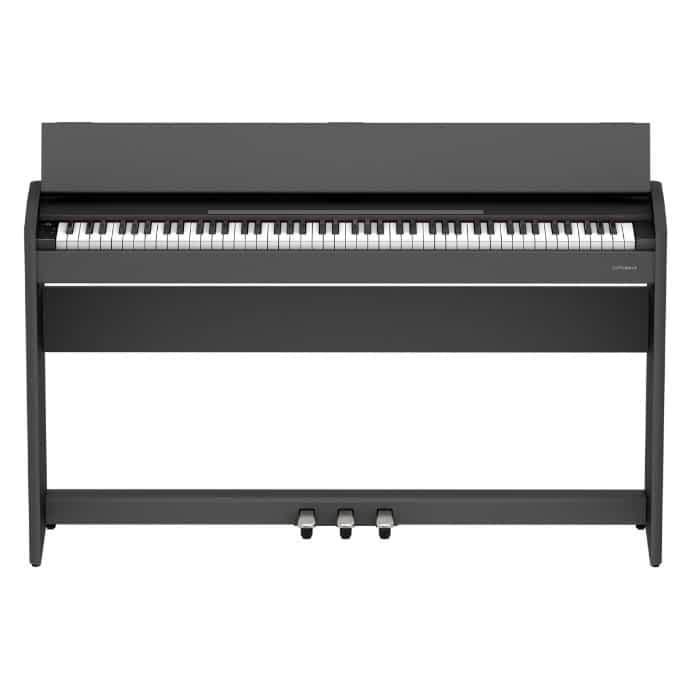
PERFECT FOR: Beginners
FEATURES: SuperNATURAL Piano technology from Roland provides world-class sounds
OTHER INFO: Can connect with Bluetooth and transmit MIDI or audio
Roland F107 Digital Piano
When you check the price above, you’ll see there are loads of great places to buy this item. Our personal favorite is Gear4music.
It is the largest music retailer in the UK and fast becoming the most respected online music shop in the US too. Their customer service is excellent, they have competitive prices, really fast shipping, and usually have the longest guarantee.
Most professional musicians use Gear4music, so there is no reason why you shouldn’t too!
- With a slim and space-saving design which fits any contemporary living space
- Extend your piano's functionality with the Roland Piano App
- The keyboard's lid folds up and acts as a sheet music stand
- More expensive compared to other beginner pianos
The professional musician who wrote this article combined many things,
from the product build, manufacturer’s reputation through to feedback
from other users, to create our famous TedScore™.
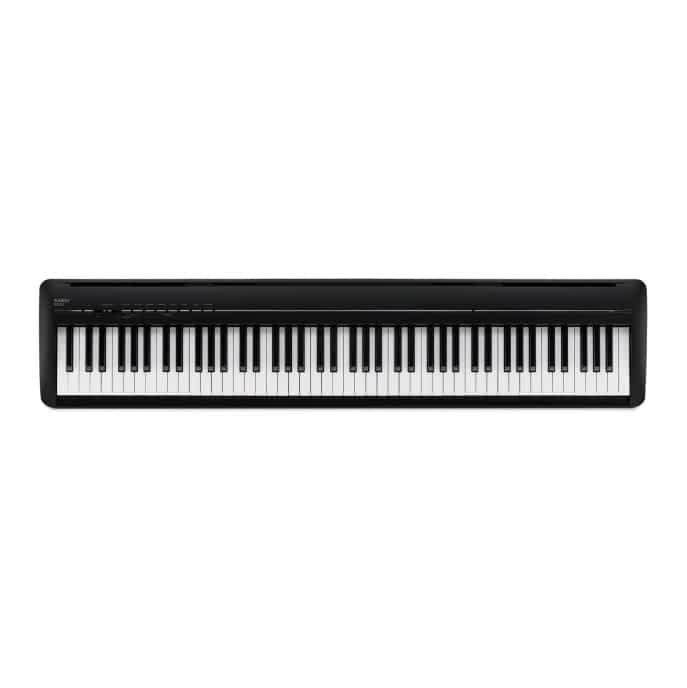
PERFECT FOR: Beginners
FEATURES: Improved action with new Responsive Hammer Compact action
OTHER INFO: Comes with a superb fully-weighted keyboard action
Kawai ES120 Digital Stage Piano
When you check the price above, you’ll see there are loads of great places to buy this item. Our personal favorite is Gear4music.
It is the largest music retailer in the UK and fast becoming the most respected online music shop in the US too. Their customer service is excellent, they have competitive prices, really fast shipping, and usually have the longest guarantee.
Most professional musicians use Gear4music, so there is no reason why you shouldn’t too!
- With 192-note polyphony
- Bluetooth audio allows for streaming device audio through piano speakers
- Comes with an extra speaker size and brand-new spatial headphone audio
- No USB functionality
- Built without a screen
The professional musician who wrote this article combined many things,
from the product build, manufacturer’s reputation through to feedback
from other users, to create our famous TedScore™.
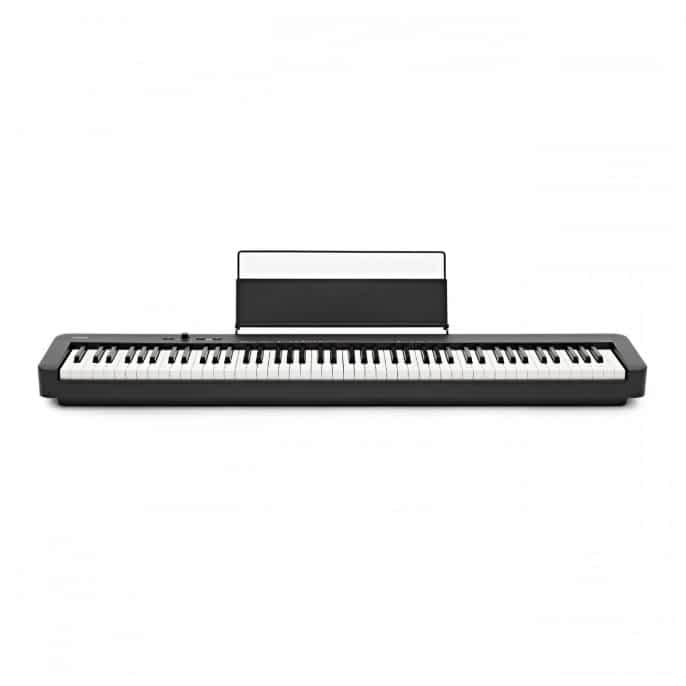
PERFECT FOR: Beginner to progressing players
FEATURES: Authentic keyboard action encourages correct technique
OTHER INFO: With an extra sleek profile for a modern aesthetic and added portability
Casio CDP S110 Digital Piano
When you check the price above, you’ll see there are loads of great places to buy this item. Our personal favorite is Gear4music.
It is the largest music retailer in the UK and fast becoming the most respected online music shop in the US too. Their customer service is excellent, they have competitive prices, really fast shipping, and usually have the longest guarantee.
Most professional musicians use Gear4music, so there is no reason why you shouldn’t too!
- MIDI-enabled for a world of opportunities
- A great student instrument, ideal for taking you through your grades
- Can easily fit into any practice space
- Some more experienced players might find it a bit limited in terms of preset sounds
The professional musician who wrote this article combined many things,
from the product build, manufacturer’s reputation through to feedback
from other users, to create our famous TedScore™.
Piano Techniques
Summary
Writing this list of piano techniques has been a delightful journey for me. Piano playing offers a world of beautiful sounds and emotions.
Proper hand positioning, practicing scales, and developing finger strength are fundamental. These are the building blocks.
I found breaking topics into small, digestible tips incredibly helpful. For instance:
- Hand Position: Keep your fingers curved and play on the tips.
- Posture: Feet flat, knees under the piano, arms relaxed.
- Scales: Incorporate them daily.
- Dynamics: Master the touch to express emotions.
Each technique brings us closer to mastery. Sharing these insights has been quite an adventure. I hope you’ve found them as engaging and useful as I did. Let’s continue this musical journey together!
Do you have a different or unique piano playing technique?
I’d love to hear from you!
And don’t forget… my new 14 Accessories For The Piano can help get you setup for motivated practice!
FAQ's
The best and most important piano technique is to get started correctly with proper posture and hand position.
Regarding the most difficult piano technique, many experts agree that the Polyphonic style is the most challenging. This style requires a pianist to play multiple melodies simultaneously, and only the most skilled and experienced pianists can do it with ease
Your posture, hand position, and touch all play a role in creating beautiful piano music. When you sit down at the piano, ensure your hands are relaxed, your wrists should be flexible and free to move, and focus on using arm weight to produce a rich, full sound.


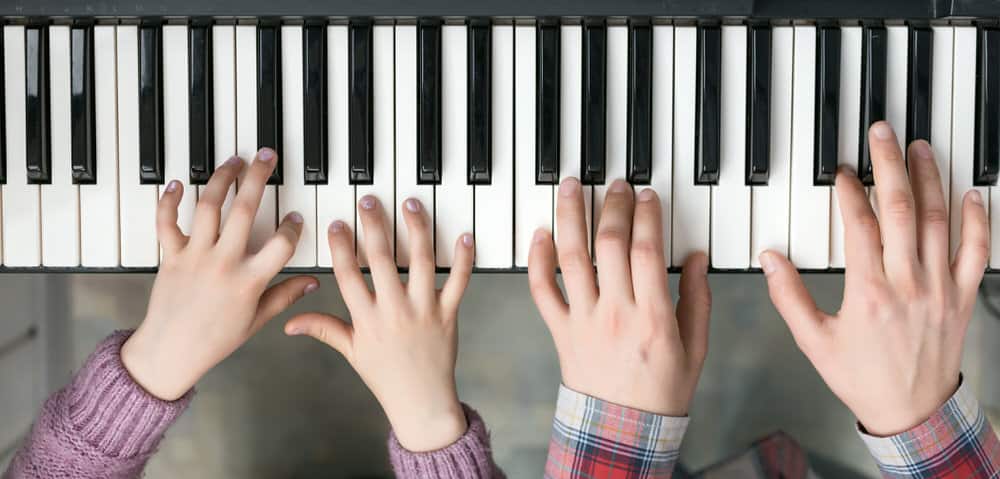

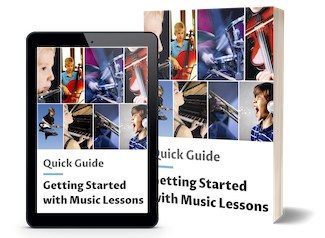





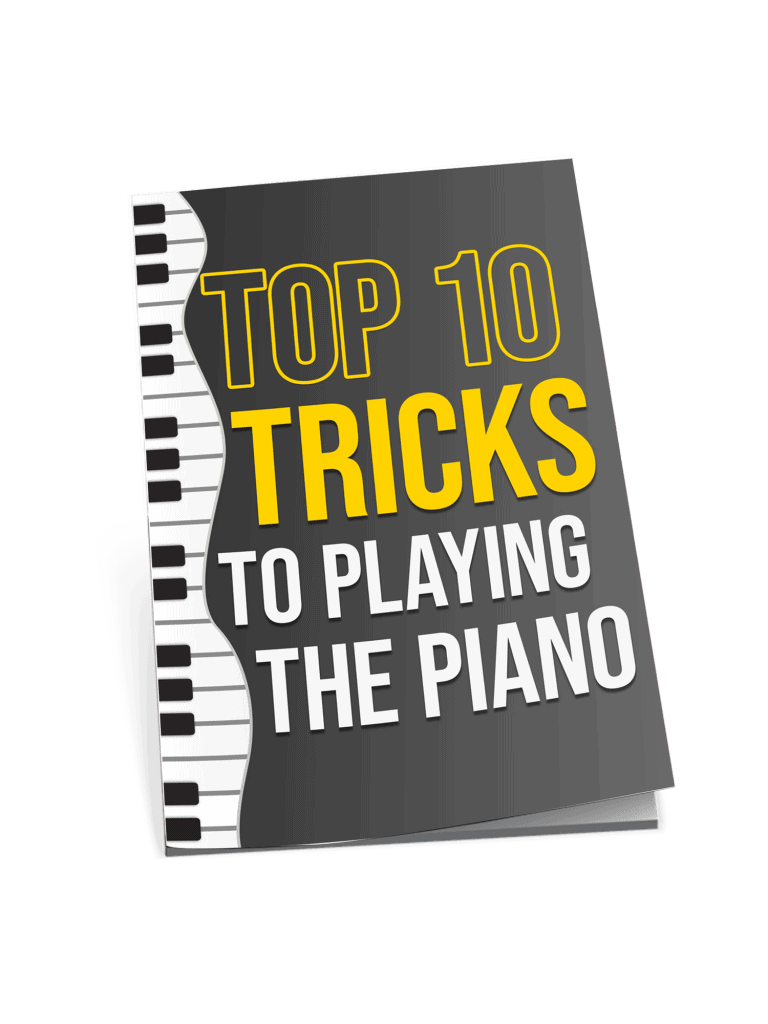
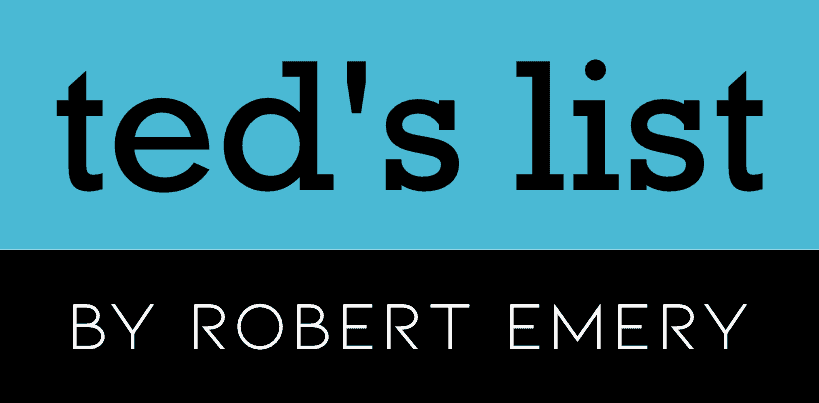
While reading through the recommended pianos for beginners, I found myself wondering about the longevity of starting with a digital versus an acoustic piano. From an investment perspective, is it wiser to start with something that mimics the acoustic experience or should the focus be on something more budget-friendly? Would love to hear others’ experiences or recommendations.
learning scales was a game changer for me, especially when i started improvising. never thought much about the octave playing though. gonna give that a shot next time i practice. anyone else find playing scales kinda therapeutic?
Absolutely, scales are the foundation and once you get the hang of them, it opens up a whole new world of playing. And yes, there’s definitely something calming about running through scales!
I’ve been trying to squeeze piano practice into my hectic schedule and found the part about having a practice schedule super intriguing. How can someone with unpredictable work hours set a realistic practice schedule? And any tips on setting clear goals that are actually achievable when you’re just starting? I want to make sure I’m not setting myself up for disappointment.